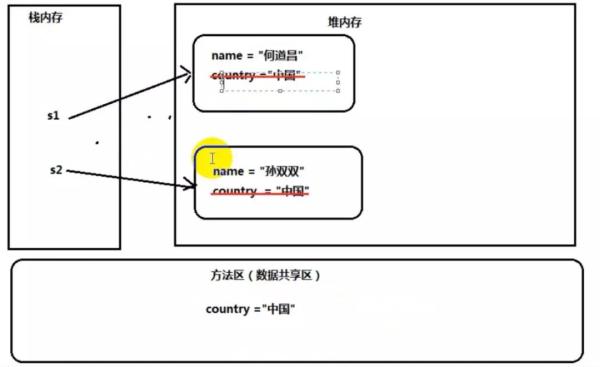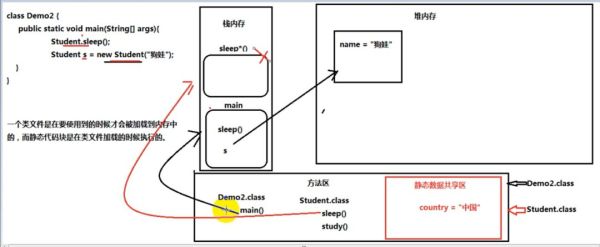彻底填平Static坑——细节决定成败

学习的过程就是填坑的过程,可不要偷懒想着跳过去,你现在跳过去,就相当于给自己挖了一个坑,你迟早会掉进去的,为了避免不掉坑,所以,努力填坑吧!
如果没有static会怎样?
需求:
1、定义Student类
- 姓名、国籍,说话行为
- 多个构造,重载形式体现
2、学生的国籍都是确定的
- 国籍可以进行显示初始化
public class Student {
String name;//姓名
String country;//国籍
public Student(String name, String country) {
this.name = name;
this.country = country;
}
public void speak(){
System.out.println("姓名:"+this.name+" "+"国籍:"+this.country);
}
}
class Test{
public static void main(String[] args) {
Student student = new Student("何道昌","中国");
Student student1 = new Student("孙双双","中国");
student.speak();
student1.speak();
}
}
运行结果:
姓名:何晶晶 国籍:中国
姓名:孙双双 国籍:中国
目前存在的问题:
现在我们已知学生都是中国人,现在我们每创建一个学生对象,就要给所有学生的国籍属性赋相同的值,这样造成堆内存空间资源浪费

目前方案:
把“中国”这个数据移动到数据共享区中,共享这个数据给所有的Student对象使用即可
疑问:如何才能把这个数据移动到数据共享区中共享呢?
解决方案:
只需要用static修饰该数据即可
静态的成员变量只会在数据共享区中维护一份,而非静态成员变量的数据会在每个对象中都维护一份

public class Student {
String name;//姓名
//使用了static修饰country,那么这时候country就是一个共享的数据
static String country = "中国";//国籍
//构造函数
public Student(String name) {
this.name = name;
}
//说话行为
public void speak(){
System.out.println("姓名:"+this.name+" "+"国籍:"+country);
}
}
class Test{
public static void main(String[] args) {
Student student = new Student("何道昌");
Student student1 = new Student("孙双双");
student.speak();
student1.speak();
}
}
运行结果:
姓名:何晶晶 国籍:中国
姓名:孙双双 国籍:中国
下面我来详细解说static
static(静态修饰符)
1.static修饰静态变量
如果有数据需要被共享给所有对象使用时,那么就可以使用static修饰
静态成员变量的访问方式:
方式一:可以使用对象进行访问
格式:对象.变量名
方式二:可以使用类名进行访问
格式:类名.变量名
注意:
1). 非静态的成员变量只能使用对象进行访问,不能使用类命进行访问
public class Student {
String name;//姓名 非静态成员变量
//使用了static修饰country,那么这时候country就是一个共享的数据
static String country = "中国";//国籍 静态成员变量
//构造函数
public Student(String name) {
this.name = name;
}
//说话行为
public void speak(){
System.out.println("姓名:"+this.name+" "+"国籍:"+country);
}
}
class Test{
public static void main(String[] args) {
Student student = new Student("何道昌");
System.out.println(student.name);//用对象访问非静态变量<br> Systen.out.println(student.country);//用对象访问静态变量
System.out.println(Student.country);//用类命访问静态变量
}
运行结果:
何道晶 中国
中国
2). 千万不要为了方便访问数据而使用static修饰成员变量,只有成员变量的数据真正需要被共享的时候,才使用static修饰
static修饰成员变量的应用场景:如果一个数据需要被所有对象共享使用的时候,用static修饰
2.static修饰成员函数(静态的成员方法)
静态成员函数的访问方式:
方式一:可以使用对象进行访问
格式:对象.静态的函数名
方式二:可以使用类名进行访问
格式:类名.静态的函数名
推荐使用类名直接访问静态的成员
原因:
1.方便
2.节省内存
静态函数要注意的事项:
1.静态函数是可以调用类名或者对象进行调用的,而非静态函数只能使用对象进行调用
2.静态的函数可以访问静态的成员,但是不能直接访问非静态的成员
3.非静态的函数是可以直接访问静态与非静态的成员
4.静态函数不能出现this或者super关键字
public class Student {
String name;//姓名 非静态成员变量
//使用了static修饰country,那么这时候country就是一个共享的数据
static String country = "中国";//国籍 静态成员变量
//构造函数
public Student(String name) {
this.name = name;
}
//说话行为
//静态成员方法
public static void speak(){
System.out.println("国籍:"+country);
}
//学习行为
//非静态成员方法
public void study(){
System.out.println(name+"好好学习");
}
}
class Test{
public static void main(String[] args) {
Student student = new Student("何道昌");
System.out.println(student.name);//用对象访问非静态变量
System.out.println(student.country);//用对象访问静态变量
System.out.println(Student.country);//用类命访问静态变量
student.study();//用对象访问非静态方法
student.speak();//用对象访问静态方法
Student.speak();//用类名访问静态方法
}
}
运行结果:
何道晶
中国
中国
何道晶好好学习
国籍:中国
国籍:中国
静态的成员变量与非静态的成员变量的区别:
1)、作用上的区别:
1.静态的成员变量的作用是共享一个数据给所有的对象使用
2.非静态的成员变量的作用是描述一类事物的公共属性
2)、数量和存储位置上的区别:
1.静态成员变量是在存储方法区内存中,而且只会存在一份数据
2.非静态的成员变量是存储在堆内存中,有n个对象就有n份数据
3)、生命周期的区别:
1.静态的成员变量数据是随着类的加载而存在,随着类文件的消失而消失
2.非静态的成员变量数据是随着对象的创建而存在,随着对象被垃圾回收器回收而消失
静态函数不能访问非静态的成员?
静态函数只要存在有对象,那么也可以访问非静态的数据,只是不能直接访问。
最后,继续用这个例子穿插一下静态代码块的知识
静态代码块是在Student.class文件加载到内存的时候就马上执行的
public class Student {
String name;//姓名 非静态成员变量
//使用了static修饰country,那么这时候country就是一个共享的数据
static String country = "中国";//国籍 静态成员变量
//静态代码块
static{
System.out.println("静态代码块执行了!!");
}
//构造函数
public Student(String name) {
this.name = name;
}
//说话行为
//静态成员方法
public static void speak(){
System.out.println("国籍:"+country);
}
//学习行为
//非静态成员方法
public void study(){
System.out.println(name+"好好学习");
}
}
class Test{
public static void main(String[] args) {
Student.speak();
}
}
运行结果:
静态代码块执行了!!
国籍:中国
理解到这,你再看看下面的分析图,应该还会有所收获

最后再跟大家分享一句话:
一个人若想改变自己的命运,最重要的是要改变自己,改变心态,改变环境,这样命运也会随之改变










![[HBLOG]公众号](https://www.liuhaihua.cn/img/qrcode_gzh.jpg)

